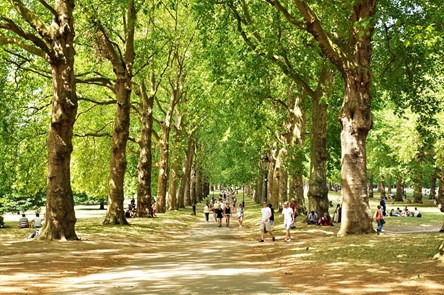The article was first published at Scottish Planner - The Journal of RTPI Scotland, Autumn Issue – Planning for COP26 / #186 / Sep 2021
In a recent ‘Generation Z’ survey carried out by Amnesty International, climate change ranks highest as the most important issue facing the world amongst 18-25 year olds. As the RTPI President, I have the privilege of meeting many young people. From our conversations, I can feel the strong sense of urgency and the desire to change. But I also hear their frustrations - many principles they learned from schools cannot be fully applied in the ‘real world’. “This is not how we do things” as they were told.
It is a time filled with clashes between high-level ambitious policies and tendencies of carrying on ‘business as usual’. Government departments and professionals are still working in the way they did in the 20th century. However, to tackle climate change and other pressing issues, transformative changes need to start from how we work with each other, how we share our data and knowledge, and how we communicate with the general public.
“It is unequivocal that human influence has warmed the atmosphere, oceans and land”. It took more than three decades for the Intergovernmental Panel on Climate Change (IPCC) to get their message listened, but sadly we do not have another three decades to plan our actions. The IPCC Sixth Assessment Report (2021) warns of increasingly extreme heatwaves, droughts and flooding, and a key temperature limit being broken in just over a decade. The danger is on every country’s doorstep. Nowhere is safe on this planet.
Although grim, there is still a final hope. Scientists say a catastrophe can be avoided if the world acts fast. Last December, the IPCC and the Intergovernmental Science-Policy Platform on Biodiversity and Ecosystem Services (IPBES) came together for the first time. The scientists warn that climate change and biodiversity loss have largely been tackled separately, even though both are driven by human activities, and both have impacts on each other (IPBES & IPCC, 2021). Climate change and biodiversity decline must be tackled urgently together, and with pollution and waste – they are immediate threats to humanity and the planet. The scientists are calling on countries to protect entire ecosystems rather than iconic locations or species. Treating climate, biodiversity and human society as coupled systems is key to successful outcomes from policy interventions.
The COVID-19 pandemic has also demonstrated strong connections between our living environment and public health, in both physical and mental terms. The most vulnerable communities experienced the worst impacts from the pandemic globally. The Institute for Healthcare Improvement’s “Triple Aim” framework” has suggested that in addition to the patient experience of care, ‘improving the health of populations’ and ‘being a good steward of the per capita cost of care’ should also be seen as important public health aims.
 How our living environment is planned has direct influence on people’s daily activities, their health and wellbeing. People’s choices for healthier lifestyles are limited by the built environment. It is evident that the vast amount of research and studies are calling for one thing – utilising place-based spatial planning in a long term, strategic, multi-disciplinary approach can be a transformative solution to coordinate the efforts from different professionals to tackle the grant challenges of our times. It is also the most direct way to influencing human activities and lifestyles. Working in silos and non-place-based policies will lead us to the dead end – a catastrophe.
How our living environment is planned has direct influence on people’s daily activities, their health and wellbeing. People’s choices for healthier lifestyles are limited by the built environment. It is evident that the vast amount of research and studies are calling for one thing – utilising place-based spatial planning in a long term, strategic, multi-disciplinary approach can be a transformative solution to coordinate the efforts from different professionals to tackle the grant challenges of our times. It is also the most direct way to influencing human activities and lifestyles. Working in silos and non-place-based policies will lead us to the dead end – a catastrophe.
I believe it is time for the planning profession to take a leadership role in forging a common and collaborative sense of purpose with other good forces in the wider society. The professional boundaries are merging; what joining us together is our shared sense of purpose - what should be done now to make our world a better place for our future generations. This is the message I am going to take to COP26 - the UN Climate Change Conference in Glasgow this November.
This reminds me when Thomas Adams (1871-1940) initiated the Town Planning Institute in the 1910s, he wanted the institute to act as a forum for all of the environmental professions and as a sponsor of research into planning problems. A professional institute in planning would ‘re-integrate the sharply divided environmental professions and oversee technical training’ (Simpson, 1985). Adams saw no fundamental distinction between professionals and amateurs, and in the view that both needed education in the appreciation of environmental problems and possibilities. I believe this is the approach we still need to take now – to welcome anyone with a shared vision to work together with us.
Planners, we come from communities and work for public interest. We are distinguished by our primary commitment to the benefit of the public and the longer-term interests of society (ECTP-CEU, 2013). Our connection with the public is the foundation of the profession. Planners need to work with communities and draw on local knowledge on the ground. From the last 19th century, work of Sir Patrick Geddes (1854-1932) promoted observation of communities based on the scientific method and civic surveys.
Planning is people centric and is about the future; it’s a subject that relates to everyone’s life. The fundamental objective of the planning profession is to create a balanced system for people, nature and society to co-exist in harmony. The full remit of spatial planning covers land and marine areas - it deals with our relationship with natural and built environments. As an applied social, environmental and behavioural science, it synthesises a variety of perspectives and approaches and is the glue that binds built and natural environment expertise together to create a better future for public interest.
Integrated spatial planning can be used as the leverage to develop a long-term vision and framework for citizens that considers multiple scales, balancing competing demands and directing resource-allocation decisions (Albrechts, 2004). But to unlock its full potential, there is an urgent need to cultivate a sustainable research, practice, and education eco-system for spatial planning to fully embrace the data and technological advances. It will enable a better engaged plan-making process and a much broader interdisciplinary collaboration, and it will allow everyone to think intelligently about the future to support well-informed decision-making.
I am full of hope for our profession. The heyday of the planning profession is coming. As UN Environment Programme suggested on the International Youth Day 2021 in August, planning will be a popular profession for young people seeking for green jobs. Let’s do our best to create opportunities for our future generations to unlock their full potentials to plan the world we need.
References:
- Simpson, M. (1985), ‘Thomas Adams and the Modern Planning Movement: Britain, Canada and the United States, 1900-1940. (London and New York, MANSELL: An Alexandrine Press Book).
- ECTP-CEU (2013), The Charter of European Planning 2013 - The Vision for Cities and Regions – Territories of Europe in the 21st Century.
- Albrechts, L. (2004), ‘Strategic (Spatial) Planning Re-Examined’, Environment and Planning B: Planning and Design, 31(5), 743–758.


